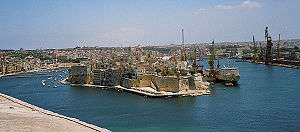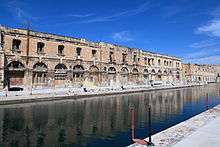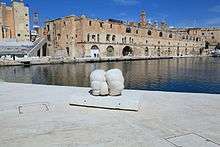Malta Dockyard

Malta Dockyard was an important naval base in the Grand Harbour in Malta in the Mediterranean Sea.
History
Pre-1800
The Knights of Malta established dockyard facilities within the Grand Harbour to maintain their fleet of galleys. These were spread between the cities of Senglea, Valletta and Vittoriosa.
19th century
When Malta became a British protectorate in 1800, these facilities were inherited, and gradually consolidated, by the Royal Navy. With the loss of Minorca, Malta swiftly became the Navy's principal Mediterranean base.[1]
The Royal Navy Dockyard was initially located around Dockyard Creek, and occupied several of the dockyard buildings formerly used by the Knights of Malta. By 1850 the facilities included storehouses, a ropery, a small steam factory, victualling facilities, houses for the officers of the Yard, and most notably a dry dock - the first to be provided for a Royal Dockyard outside Britain.[2] Begun in 1844, the dry dock was opened in 1847; ten years later it was extended to form a double dock (No. 1 and No. 2 dock).[1] Allegedly, marble blocks from the Mausoleum at Halicarnassus, one of the Seven Wonders of the Ancient World, were used for the construction of these docks.[3]
In the second half of the century the steam factory with its machine shops and foundries was expanded. Very soon, though, it was clear that more space was required than the crowded wharves of Dockyard Creek afforded, to accommodate the increasing size of ships and the increasing size of the fleet based there. The decision was taken to expand into the adjacent French Creek, and between 1861 and 1909 a further five dry docks (three single plus one double dock) were constructed there, along with an assortment of specialized buildings to serve the mechanized Navy.[1]
| Naval Dockyard buildings | ||||||||
|---|---|---|---|---|---|---|---|---|
|
20th century

It was an important supply base during the First World War and the Second World War. In January 1941 sixty German dive bombers made a massed attack on the dockyard in an attempt to destroy the damaged British aircraft carrier Illustrious, but she received only one bomb hit. Incessant German and Italian bombing raids targeted Malta through March, opposed by only a handful of British fighters.[5] Then in April 1942 the Admiral Superintendent of Malta Dockyard reported that due to German air attacks on Malta's naval base "practically no workshops were in action other than those underground; all docks were damaged; electric power, light and telephones were largely out of action."[6]
The dockyard was handed over to Baileys, a civilian firm of ship repairers and marine engineers, in 1959.[7] After Baileys were dispossessed by the Maltese Government[8] the dockyard was closed as a naval base and the Royal Navy withdrew completely in 1979.[9] It was then managed by a workers' council between 1987 and 1996 repairing civilian ships.[10]
List of Admirals Superintendent of Malta Dockyard
The dockyard was managed by a Resident Commissioner until the Resident Commissioners at all dockyards were replaced by Admirals Superintendent at the end of 1831.[11] Admirals Superintendent included:[12]
Admirals Superintendent of Malta Dockyard
- 1832-1838 Rear Admiral Thomas Briggs
- 1838-1843 Rear Admiral John Louis
- 1843-1848 Rear Admiral Lucius Curtis
- 1848-1853 Rear Admiral Edward Harvey
- 1853-1855 Rear Admiral Houston Stewart
- 1855-1858 Rear Admiral Montagu Stopford
- 1858-1863 Rear Admiral Henry Codrington
- 1863-1864 Rear Admiral Horatio Austin
- 1864-1868 Rear Admiral Henry Kellett
- 1868-1870 Rear Admiral Edward Fanshawe
- 1870-1872 Rear Admiral Astley Key
- 1872-1876 Rear Admiral Edward Inglefield
- 1876-1878 Rear Admiral Edward Rice
- 1878-1879 Rear Admiral William Luard
- 1879-1882 Rear Admiral John McCrea
- 1882-1885 Rear Admiral William Graham
- 1885-1887 Rear Admiral William Ward
- 1887-1889 Rear Admiral Robert Douglas
- 1889-1892 Rear Admiral Alexander Buller
- 1892-1894 Rear Admiral Richard Tracey
- 1894-1897 Rear Admiral Richard Duckworth-King
- 1897-1900 Rear Admiral Rodney Lloyd
- 1900-1902 Rear Admiral Burges Watson
- 1902-1905 Rear Admiral James Hammet
- 1905-1907 Rear Admiral Arthur Bromley
- 1907-1910 Rear Admiral Frederic Fisher
- 1910-1912 Rear Admiral Ernest Simons
- 1912-1914 Rear Admiral Sackville Carden
- 1914-1916 Rear Admiral Arthur Limpus
- 1916-1918 Rear-Admiral George Ballard
- 1918-1921 Rear Admiral Brian Barttelot
- 1921-1924 Rear Admiral John Luce
- 1924-1926 Rear Admiral Charles Johnson
- 1926-1928 Rear Admiral Alexander Campbell
- 1928-1931 Rear Admiral Francis Mitchell
- 1931-1934 Rear Admiral Matthew Best
Flag Officer, Malta
- 1934-1937 Vice Admiral Sir Wilfred French
- 1937-1941 Vice Admiral Sir Wilbraham Ford
- 1941-1942 Vice Admiral Sir Ralph Leatham
- 1942-1943 Vice Admiral Sir Stuart Bonham Carter
- May-Oct 1943 Vice Admiral Arthur Power
- 1943-1945 Vice Admiral Sir Louis Hamilton
- 1945-1946 Vice Admiral Sir Frederick Dalrymple-Hamilton
- 1946-1948 Rear Admiral Marcel Kelsey
- 1948-1950 Rear Admiral Philip Clarke
- 1950-1952 Vice Admiral Sir Geoffrey Hawkins
- 1952-1954 Rear Admiral Jocelyn Salter
- 1954-1957 Rear Admiral Wilfred Brittain
- 1957-1959 Vice Admiral Sir Charles Madden
- 1959-1961 Rear Admiral Derick Hetherington
- 1961-1963 Rear Admiral Viscount Kelburn
- Note: The post was vacant between 1963 and 1967
- 1967-1969 Rear Admiral Dudley Davenport
- 1969-1971 Rear Admiral Derrick Kent
- 1971-1973 Rear Admiral John Templeton-Cotill
- 1973-1975 Rear Admiral David Loram
- 1975-1979 Rear Admiral Sir Nigel Cecil
References
- 1 2 3 Coad, Jonathan (2013). Support for the Fleet: Architecture and engineering of the Royal Navy's bases, 1700-1914. Swindon: English Heritage.
- ↑ "Malta Harbour". Retrieved 12 October 2013.
- ↑ Busuttil, Cynthia (26 July 2009). "Dock 1 made from ancient ruins?". Times of Malta. Retrieved 15 March 2015.
- ↑ "Allied shipping losses".
- ↑ Macintyre, p. 169
- ↑ Macintyre, p. 224
- ↑ "Malta's Royal Navy Dockyard handed over". ITN. 1959. Retrieved 12 October 2013.
- ↑ "Malta: British Documents on End of Empire edited by Simon C. Smith". Stationery Office Books. 2006. p. 417. ISBN 978-0112905905. Retrieved 12 October 2013.
- ↑ "Dockyard foreign ownership would take Malta to pre-1979 days - CNI". Times of Malta. 8 September 2008. Retrieved 12 October 2013.
- ↑ "Requiem for a Dockyard". Malta Today. 7 April 2010. Retrieved 12 October 2013.
- ↑ "Chatham Dockyard". battleships-cruisers. Retrieved 3 February 2015.
- ↑ "Senior Royal Navy appointments" (PDF). Retrieved 2 February 2015.
Sources
- Macintyre, Donald, The Naval War Against Hitler, New York: Charles Scribner's Sons, 1971


_02_ies.jpg)